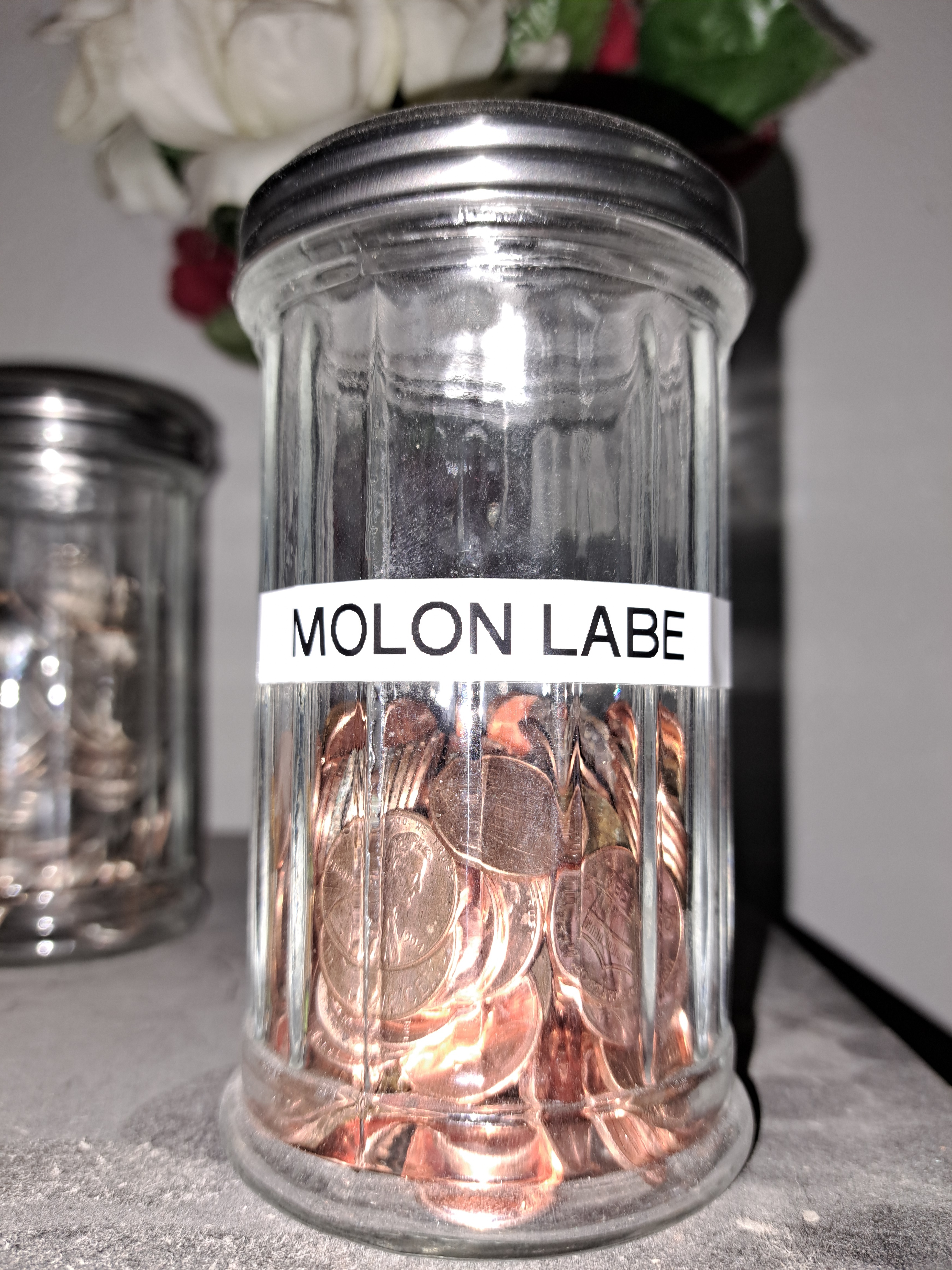- cross-posted to:
- [email protected]
- cross-posted to:
- [email protected]
I’m all for it. Real talk though: at what point do we consider re-basing the dollar? I get that we’re nowhere near that now, but I’m guessing it’s at the “kill the $1 bill” mark?
I’d answer this with ‘we rebase the dollar when a coin can’t buy a thing.’ It should have happened decades ago. Here’s my worked example.
A penny used to be a lot of money. You could buy actual things with a penny. I’m sure our oldest contributors can point to the day that a penny would get you a piece of candy. In my earliest days, I could get that same piece of candy with a nickel, but by my teens, that piece of candy would be a dime or even quarter. I remember when a bag of M&Ms cost $0.50, That became $1.00 around the 2000s, and is now $2.00.
A penny sitting on the ground was ‘good luck’ back in the day. I think that’s because you could bend down, pick up that penny, head to the store, and plink that penny down and get something in exchange for it. Today, you can’t plink down a single penny for anything. You can’t even plink down 10 of these pennies or a dime and expect to get something today, with the cheapest things requiring 25 of these coins (or a single quarter). Not much luck if you need 25 of them to get a burst of sweetness.
If we did away with the penny, would anyone lose anything? That’s 5 seconds at Federal Minimum Wage, and about 2 seconds at my city’s minimum wage. It takes more time to reach down and pick up the penny than you’d earn working a minimum wage job, so arguments about ‘Oh, prices will go higher if we eliminate the penny’ ring hollow to me. There is functionally no difference between $7.99 and $8.00 pricewise. Even a hike of a $7.9 priced item to $8 isn’t a bunch of money. We’re almost to the point where you can’t buy something with a single dollar bill. The time for the hundredth of that dollar bill passed a LONG time ago.
I recall the gumball machine at my childhood barber being a penny in the mid 1980s. I don’t recall when it went up exactly, but it was around then. I was born in 80 so I was pretty young when it happened. But yeah, even then the convenience store in the middle of town had a candy aisle with lots of 5 cent candy that made picking up pennies worthwhile.
I also remember in the later 80s when I began reading them, comics were $0.75 each. Over the next 15 years they went to $3, until I was in college and my comic habit was just too expensive, so I stopped the monthlies completely.
Inspired by your comment, I decided to look up when the U.S. stopped minting the half penny, as well as what a “half penny” of that time would’ve been worth when accounting for modern inflation.
The U.S. half penny was abandoned in 1857. The inflation calculators I checked don’t allow for division by half-cents, but when $0.01 from 1857 is inflated to today’s value, it comes out to somewhere between 37¢ and 38¢. If I did the math correctly, that means a U.S. half cent was worth a modern equivalent of about 19¢ at the time it was discontinued.
Good, we should have done this 20 years ago.
Death to nickels!
I assume you’re alluding to this - https://youtu.be/58SrtQNt4YE
He’s not a good source for economic analysis. He has no background in the subject. This would have a fallout that would harm the most vulnerable.
Indeed.
Agreed, why just the penny, eliminate the whole decimal place.
I’ve got a great business idea: I’ll collect a few million dollars worth of nickels and sell them back to the government for 10 cents each. That’s about a 28% discount to the manufacturing cost, and I’ll double my money. Win-win!
The problem is you can’t get rid of nickles without getting rid of either quarters or dimes too. Without nickles you would have a denomination (25c) that has no way to be made by lower coins (10c dimes can’t equal 25c). So you either need to get rid of every coin, every coin except the quarter, or nuke the quarter and nickle concurrently and only use dimes, forcing prices to be multiples of 10.
Just use dimes and half dollars
Unfortunately half dollars are comically large
They don’t have to be. The old silver dollar coin was huge, but the sacagawea dollar coin is no bigger than a quarter
It would be a poor idea to introduce a coin that couldn’t be easily accommodated by coin-op machines. The Sacajawea was specifically designed to be the same size and magnetic signature was previous dollar coins so that coin-op machines that has taken “silver dollars” would also take Sacajaweas without updating.
I think this is the way. And, in memoriam of the quarter and to celebrate the massive increase in half-dollar production, we open with a 50cents for 50states where we produce half-dollars with 50 alternative “tails”, one for each state.
I doubt it’ll happen in this administration, but at least we are getting rid of the penny, finally.
We’d need a massive public awareness campaign to let them know we’re even allowed to change this.
Replace the quarter with a 20¢ piece. Then you can keep getting rid of the lowest coin.
Why do you need to be able to make every denomination from every other one?
Its just awkward if something costs 1.15 and you just have a dollar and two dimes. No way to make change for that despite it can be summed from coins (3 quarters 4 dimes) so it will for sure occur in a real world situation where nickels are gone.
Imo a funnier (unrealistic) solution would be to just change the value of the dime to 12.5 cents.
That isn’t the specific problem. The problem is that you need a way to make up the difference between them. Example: If someone pays $1.00 for something that costs $0.35, how do you make change without a .05 denomination?
It’s the same issue with the penny, you round up or round down.
If you have no penny, when taxes on your item make the total equal to $5.03, you pay $5.05. if the total is $5.02 you pay $5.00.
Businesses will round up in both cases
When I was implementing penny-rounding for Canada in Point-of-Sale software, I was told we were legally required to round in a specific way.
I would imagine the U.S. probably will do something similar. Tho, we might follow the model of some of the other countries that have eliminated their pennies. Executive orders are a poor way to cover all the knock-on issues that some with eliminating the penny.
Sure, but the rounding errors become a lot bigger if you get rid of the nickel.
As long as there’s no collusion it should generally even out with random purchases. Unless you constantly buy the same order every day that ends in 3 cents and rounds up you might pay like $5 more every year.
Turn the dime into 12.5 cents.
Bring back the bit!
The more I think about it, the more I like it:
- Eliminate the Penny, Nickel, and Dime
- Bring back Old West nomenclature
- IT’S AMERICAN AS FUCK!
- Will drive the metric nerds absolutely batshit. “Of course we have an eighth* of a dollar, why would we use decimal?!”
* I think just the spelling of eighth will spin eurotrash into a tizzy
Suppose you want to buy something that costs a quarter, and what you have is 3 dimes. If there isnt a 5 cent coin, this creates a situation where you have enough money, but making exact change isnt possible, which while not impossible to deal with is bothersome. If we moved to only dimes and no quarters or nickels, it would never make sense to make a price end in 5 cents, so any price would be a multiple of 10 cents and change can always be made. Alternatively, if you get rid of dimes and nickels but keep quarters, then it doesnt make sense to charge a price ending in something other than .00, .25, .50, or .75, and so you can always make change for those prices with the coins one would have.
Literally none of this matters anyways if pennies are going, because making prices end in certain amounts won’t work as nice in practice as it does here for the simple reason that US prices almost never include taxes.
I mean, presumably fractions of a dollar still exist as a concept even if the coins don’t, so if you’re selling something that someone might buy in cash, one could just set the sticker price so that the final price plus tax ends up as a round number, essentially including tax when deciding on price and then taking it out again when making the labels, if one wanted to do that.
Why’s it a bad idea to get rid of coins at this point anyway. What can you still buy that is a fraction of a dollar that actually matters? Anything that cheap can just be sold in multiples that amount to even dollar amounts.
Getting rid of coins and rounding to nearest dollar sounds great to me but I don’t know what the drawbacks are.
“Getting rid of coins and rounding to nearest dollar sounds great to me but I don’t know what the drawbacks are.”
I just want to thank you for having the best analysis that I will see today. You are correct that this would be bad and it is nice to see that you understand that you might not see this.
We would be screwing the poorest very hard by making everything round up. Should we have the person literally counting pennies suffer because you want fewer coins in your pocket or because the “it costs more to make than it’s worth” people are too daft to get that we use pennies many times over?
removed by mod
There’s still some edge cases floating around. Some laundromats, parking meters, using a shopping cart at Aldi, older vending machines, bottle deposits, probably a few more but that’s off the top of my head.
Chad Kroeger and his fans have been through enough. LEAVE HIM ALONE! LEAVE CHAD ALONE!
Chad walks into a committee meeting to explain why we should end the production of our copper familiar. “LOOK AT THIS PENNY GRAPH, every time I do it makes me laugh”
So what happens when someone pays cash at the supermarket? Who rounds up?
I saw an interview with an economist years ago where he said that if we just followed the accepted rules of rounding (1-4 rounds to 0, 5-10 rounds to 10) then it would work out about the same. In reality I’m sure companies would just pocket the extra money
They already do with sales tax. ( If the tax works out to a fraction of a cent, almost every register or POS system will round up…it’s a tiny amount per transaction, but it does happen and adds up over daily, weekly and monthly transactions)
I write POS software, and have written tax calculations that cover about 30 states, and several CA provinces.
While we do have to round (always up) when calculating sales tax, there’s no way for the business to figure out how much that rounding would be, since it’s just added to the tax collected.
And in all states that I’ve worked with, a business has to pay what they collected (even if they over collect), and can’t just calculate a percentage of total sales (since many states have tax tables, rounding rules, or 3-4 decimal tax rates, and not a flat percentage tax).
So it’s actually the government that gets the benefit of the rounding.
Is that why sales tax is always on its own line on the receipt and it’s own account number on the trial balance?
Yea, we can process 4 different tax rates, and always list them separately.
The exception is in locations where tax is included in the price: bars that take a lot of cash tend to want to make everything even dollars, or quarters at the most, so that bartenders don’t have to make a lot of change, and can work quickly.
In these situations, we have to do the calculation backwards after the fact, but it’s still tracked as a separate tax in software.
I write POS software
Don’t be so hard on yourself!
I write POS software
I don’t know if you’re in any position to suggest decisions, but your software is often run on subpar hardware. Going to touchscreens doubled our call time, it was because of the half second or so of loading between touches. It couldn’t be used naturally because of the delay.
I’m an owner, so make many decisions (but I also have smart employees who’s opinions I trust very much).
This is a tough one to deal with, especially with smaller Android based handheld devices. In the 5" to 6" range we can get a few different things (wholesale costs):
- $150 - $200 dollar trash that will fail in a short period of time (Chinese imports direct from Alibaba / the manufacturer). << we don’t sell these.
- $300 to $400 devices, with similar hardware specs to the cheaper ones, but better made to last a couple of years (both of these classes are slow, and a bit under-powered)
- $900+ devices that are fast and well made.
You can guess which ones we sell the most of. Especially since they tend to get dropped, or lost quite a bit (we’re in the restaurant POS business).
For the stationary (15" Android) terminals, the situation is similar. But we sell these devices more than the handhelds, and after a few installs with well made but slower hardware, my tech lead ruled out offering the cheaper ones in favor of selling the ones with better specs, so that’s where we are now.
But lots of our competitors give hardware away to get the credit card processing revenue (a total rip off for the customer, but it’s the nature of the game), so they use the cheapest option.
Didn’t know that was the case, thanks for correcting me.
You were right about the rounding / keeping the extra … it’s just someone different keeping the extra money.
Yes we all saw office space
Yes we all saw office space
The ol Superman III
There’s still a fuck ton of pennies in circulation and on the ground, unless they consider them no longer legal tender we’ll have plenty.
However, if we end up following how Brazil does it, in my experience, it depends on the person/vendor and the amount. If you buy something that’s like R$3,99 you’ll usually get give them R$4 and that’s it. I’ve also had it where I’ll pay for something that’s say R$4,89, give them R$5 and get 15 or 25 centavos back. Could also depend on what’s in the drawer at that time.
Corporations will 100% pocket the difference at first, but once it becomes a normal thing to do the rounding I’ll wager it’ll fall to the Brazilian method, especially with local businesses or vendors.
In other words, no register will ever come out balanced.
We follow normal rounding rules in Canada. 1, 2 round down to 0. 3, 4 round up to 5. 6, 7 round down to 5. 8, 9 round up to 10.
Can you game the system? Yes!
As a business, make sure all your prices (plus tax) come to a price ending in 3, 4, 8, or 9. When consumers buy a single item you’ll get the rounding up (edit: if they pay cash) and make sweet, sweet profit. But if they buy more than one item, you’re SOL on controlling the rounding.
As a consumer, you have way more control. First, pay with cash whenever the price will round down and you can probably “profit” 5 or so dollars a year. (Assuming you pay with cash on or two times a day, saving 1 to 2 cents each time.) Pay with credit or debit each time the price
willwould round up.Second, you can get real fancy. You can learn tax rules in depth so you know what items will or won’t be taxed and at what rate (we have federal and provincial taxes but they don’t apply to everything and they don’t follow the same rules on what is taxed.) But, you can use this info to always know what the final bill will be and always buy combinations of items that end in 2 or 7 (or 1 and 6 if you’re lazy) and always pay cash. You can profit like $20 a year or something doing this.
In reality? No one gives a shit until that one rare time you’re paying with cash and it rounds down. It’s your lucky day and you do the Six Flags Man dance. It’s like finding a penny and picking it up.
Pay with credit or debit each time the price will round up.
I don’t think it matters with credit or debit. The exact amount is paid.
Yes, that’s why you pay with credit/debit. To avoid the round up.
I changed “will” to “would” to hopefully make it more clear.
That’s what OP it’s implying.
Just don’t pay with a prepaid card and you should be fine /s

If you’re gonna flex with an ancient Greek quote, at least use Greek letters!
I don’t know that the label gun does Greek. :)
*brag, the word is brag.
Sorry. Use Greek brag.
Better late than never. While the momentum is here, get rid of the nickel too.
Don’t nickels cost like 14 cents each, and won’t we need a lot more of them?
We reuse these coins so the cost to produce them is unimportant.
Oh for sure, but if the justification is that the penny costs more to make than it is worth then isn’t the nickel in that same boat?
yes, Im not arguing to get rid of coinage.
nice, we need to kill our fucking euro cents too!!!
In NL we rounded off before the euro, only had 5, 10 and 25ct coins (and 1 and 2,5 guilder); after the euro came we all of a sudden had more coins (1, 2 , 5, 10, 20, 50) but within a few years collectively stopped using the 1 and 2 cent coins. Don’t know who started, but I’m always a bit surprised when I’m in another eu country and get a single cent as change. I mean they eventually add up to something but it takes forever until you could theoretically buy something with it.
They should keep pennies and put Trump’s face on them so I can throw them in the trash
I literally throw them in the trash. I don’t see many of them because my cash transactions tend to be decimaless.
Oddly reminiscent of the Roman empire.
I guess this is a good thing, but I can imagine some companies taking advantage of this
Canada did this thirteen years ago.
Cool. Do the dollar bill next. Go buck and doublebuck coin like Canadia did.
If I can’t buy a gallon of milk or gasoline with it, it should be a coin.
I mean… it’s been a while since I’ve even seen one
frankly they might aswell cut the 5 cent piece too while theyre at it.
Just scrap anything less than $1. Then make coins $1 $5 $10 $20 that look and feel similar to the penny, nickel, dime, & quarter but are really replacing these paper bills.
Why would you want coins instead of paper bills?
They last a lot longer. This is why Canada switched to coins for $1 and $2
They last longer. Up to this point the government could not get the public to adopt the $1 coin, largely because it was too big physically, and cashiers didn’t have an extra slot in their coin drawer. We could change all that now, if we convert $1, $5, $10, and $20 into coins the appear similar to the penny, nickel, dime, and quarter.
We want the fantasy-trope coin-pouch hanging from our belts! We’ll tors down bags of coins! It’ll be great!
Homie just wants to have his pants constantly jingling.
Make a 20¢ piece instead of the quarter and everything can go to the nearest 10¢. Then eventually we can get rid of the dime too and everything can go to the nearest 20¢.
Please do not put the idea in Trump’s head that he can mint new denominations. They will all have his face.
This is the forward thinking we need right now.
No, forward thinking is to depreciate the dime, ahead of its time. When the penny was introduced it was worth the equivalent of 37 cents today. Round only to quarters. No new coins - a new 20 cent piece wouldn’t be compatible with coin infrastructure today.
This is what the euro currency did, I expect for this reason.
Just have a $1 coin that can snap into 10 pieces like a chocolate bar. And a $100 note that tears into 10 pieces like a book if stamps.



















